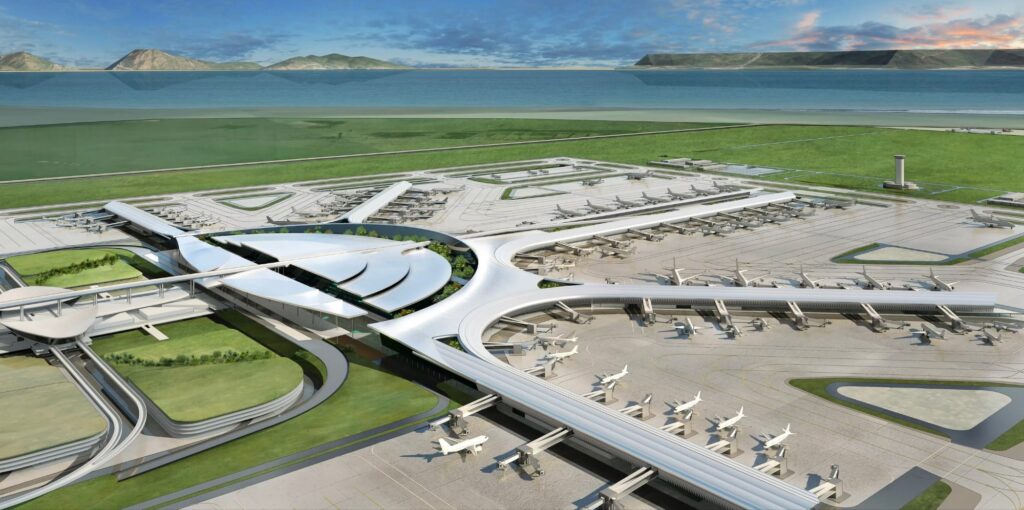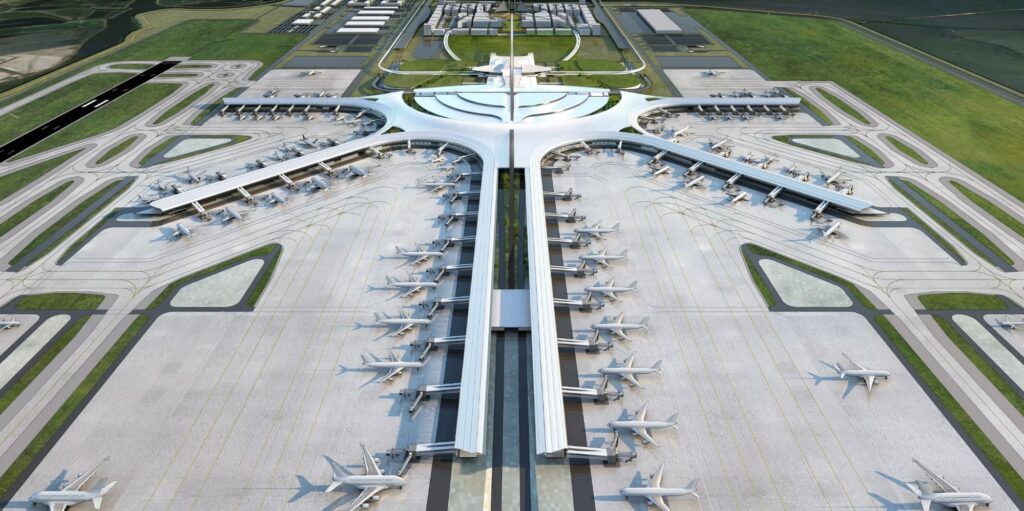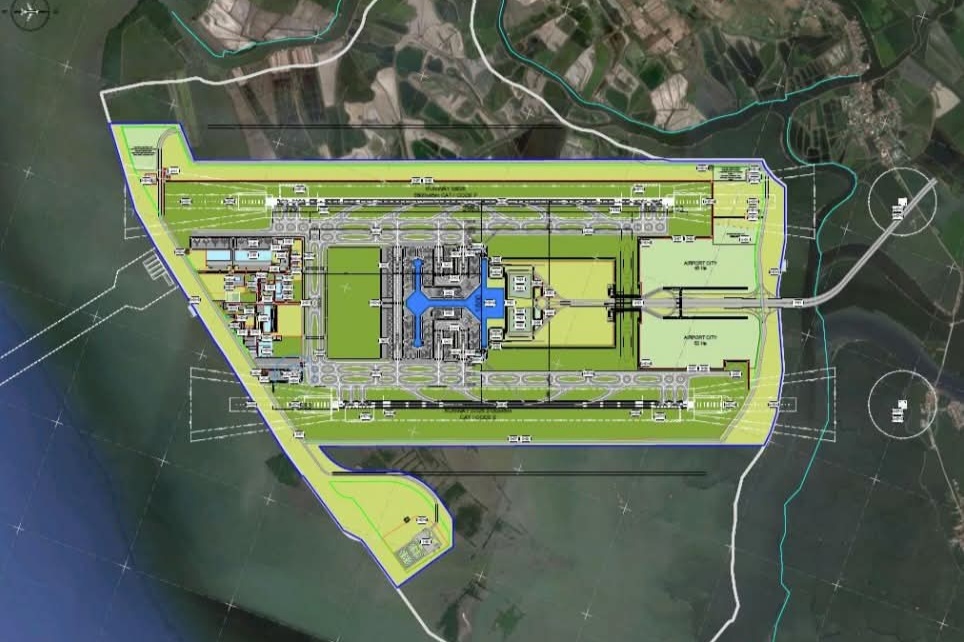Sinking soil, rising seas: Trouble for the Philippines’ $15-B mega-airport
The Philippines is building a $15-billion airport on land it had to dredge from the sea — and experts say that same sea, along with sinking soil beneath it, could cripple the project within decades.
The warnings intensified after The B1M, a major construction media outlet, spotlighted how the megaproject’s bold ambitions may be undermined by what lies beneath it.

The New Manila International Airport, or NMIA, is planned as a 2,500-hectare aviation hub capable of handling 100 million passengers a year—twice the footprint of JFK and nearly three times the size of Sydney Airport. It is intended to replace the overstretched Ninoy Aquino International Airport (NAIA), which has been operating far above its original 35 to 40 million capacity and has become notorious for delays and overcrowding. Yet the decision to build on reclaimed land along a flood-prone coast has placed the airport at the center of an intensifying debate about engineering limits and environmental reality.
Fred Mills, founder of The B1M, lays out the stakes directly: “Oh, and within 30 years, sinking land and floods could render this $15 billion project completely defunct.”
The warning stems from a growing divide between the project developer’s sea-level projections and independent scientific assessments. San Miguel Corporation (SMC), the firm behind the airport, estimated that Manila Bay would see annual sea-level rise of just 5.3 millimeters through 2050. Scientists tracking satellite data disagree sharply.
Disaster risk reduction consultant Olaf Neussner said the project’s feasibility study leaned toward numbers that appear out of step with the region’s documented exposure. “You should take the worst case scenario somehow but the feasibility study went the other way. They took the most optimistic data,” he said.
Measurements show Manila Bay rising by 13 to 15 millimeters annually, nearly triple the figure used in the airport’s design. Neussner explained that global averages do not reflect regional dynamics influenced by warming oceans, shifting currents, and the stereodynamic effects of melting ice.
“The measurements in the Manila Bay are much higher,” Neussner said. He added that intensifying typhoons, storm surges, and more extreme rainfall cycles will heighten flood danger. “The most likely scenario is increased floods in some areas, including, of course, Manila or the New Airport area.”
The airport’s location in Bulacan—already one of the most flood-prone provinces in the Philippines—compounds the concern. The site sits on soft clay and loose sand, materials highly susceptible to liquefaction during earthquakes. Still, construction moved ahead at a pace rarely seen in Southeast Asian infrastructure.
Just four years ago, the area was largely sea and agricultural fields. Dutch dredging company Boskalis transformed it into a new landmass using 150 million cubic meters of imported sand harvested from multiple global sites. Dredging vessels vacuumed sediment from seabeds and deposited it into Manila Bay before engineers began stabilizing the platform.
Mills explains the central engineering challenge: “The problem with dumping sand and sediment into the sea is something called soil liquefaction.”
To reduce that risk, workers employed dynamic compaction by dropping 10- to 20-ton hammers from heights of up to 25 meters. They layered in geogrids, deep cement mixing, and prefabricated vertical drains, then applied vibroflotation—vibrations combined with pressurized fluid—to densify the ground. Rock revetments now shield the edges of the site from coastal erosion, and the entire platform is being elevated to roughly four meters above sea level.
Even with these measures, the project suffered delays after Boskalis ran out of construction-grade sand, a resource now so scarce that nearly 7 billion tons are dredged worldwide each year, fueling environmental degradation and conflict. The pause set the timeline back by at least a year and highlighted the global strain on sand, now the second-most consumed resource after water.
Alongside those delays, environmental and social issues have increasingly intensified the controversy.
Conservationists say mangrove replanting efforts used the wrong species, reducing their effectiveness as natural flood barriers. Coastal communities reliant on Manila Bay’s fisheries and wetlands have been displaced or cut off from livelihoods.
“Over 700 families and around 3,000 people will be directly impacted by this airport by being displaced, some of them with little or no compensation,” said Francisca Stuardo of Global Witness. She warned that the disruption extends far beyond the immediate relocation areas.
Critics have also questioned the project’s classification as “land development” rather than “land reclamation,” a distinction that appears to ease regulatory hurdles. While portions of the land existed before the project, the volume of imported material makes the definition contentious. The B1M said SMC has not yet responded to requests for comment.

Despite lingering concerns, construction continues to accelerate. Plans call for a single vast passenger terminal designed to process all 100 million travelers annually, six concourses extending from the main hall, a 52,000-square-meter cargo terminal capable of handling 500,000 tons of freight each year, and four runways from 2,600 to 3,500 meters with a combined capacity of 240 aircraft movements per hour.
New access roads of 8 and 18 kilometers are being built, with rail connections expected later. The airport will serve as the centerpiece of a 12,000-hectare aerotropolis envisioned to include housing, government complexes, an industrial zone, and a seaport. Construction on the airport structures is expected to begin in 2026.
For Mills, the tension between ambition and risk remains unresolved. “At $15-billion, this project does feel like an enormous gamble,” he said, echoing concerns from engineers, scientists, and environmental groups who warn that without more rigorous safeguards, the Philippines may find its most expensive infrastructure project threatened by the very forces it was meant to withstand.



0 Comment